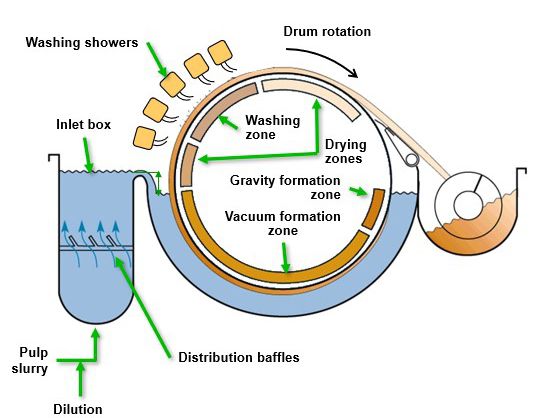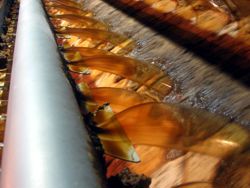5 Keys to Better Pulp Washing Operations (tips from the OEM)
Tips from the OEM experts for CORU-DEK vacuum washer technology
Pulp mill personnel often search for ways to increase capacity and efficiency across the Fiberline. Taking steps to improve the overall performance of existing washing equipment can make a positive impact on achieving those goals. In a recent interview, the Process Engineers and Product Managers from Valmet’s vacuum washer team offered five helpful tips for operators.

Typical vacuum washer arrangement
1. Understand the importance of hydraulic capacity
It is important for mills to pay close attention to hydraulic capacity because it has a direct impact on washing performance. The hydraulic capacity indicates the filtrate flow passing through the washer. If the amount of the filtrate flow passing through the cylinder and discharge assembly is too great, the discharge consistency and overall washing efficiency will be reduced. Reductions in discharge consistency and washing efficiency occur when there is not enough filtrate being removed from the pulp. More filtrate left in the pulp mat means more lignin and other solids are left behind, resulting in lower quality pulp being discharged from the washer.
By installing a new cylinder and discharge valve assembly with the OEM recommended hydraulic capacity, mills can be confident that more filtrate will pass through the pulp mat and produce higher discharge consistency for better washing efficiency.
2. Get to know your filtrate
The filtrate flowing around and through the vacuum washer is a very important aspect of pulp washing. Specifically, the impact of the speed of the filtrate on vacuum has an impact on performance. The velocity filtrate flow down the drop leg can affect the performance of the washer and should remain within a certain range to maintain the desired amount of drop leg vacuum. Lower velocities lead to lower drop leg vacuum. Lower levels of drop leg vacuum make it more difficult to pull filtrate through and out of the pulp mat, thus reducing washer efficiency.
3. Monitor discharge consistency
The discharge consistency of the pulp mat is a key data point because it is used for determining things like the dilution factor, hydraulic loading, and estimated drop leg flow. Each of these measures are used to determine a washer’s performance at any given point in time. To properly monitor discharge consistency, it is common to take one (1) discharge consistency sample per shift from each washer, or from the final washing stage of a brownstock line during normal operation.
4. Beware of pulp mat re-wetting
Pulp mat re-wetting occurs when the filtrate pulled out of the pulp mat spills out of the drainage channels (underneath the decking) back into the pulp mat. Re-wetting reduces the discharge consistency and washing efficiency.
This effect occurs on cylinders that have wire wound decking installed, which have a slot that goes from top to bottom of the decking. Whereas Valmet’s CORU-DEK® decking only has a slot at the top of the decking. This creates a 'bucket' below the slot in the decking which holds much more of the filtrate in the drainage channel, preventing it from re-wetting the pulp mat. This reduction in pulp mat re-wetting increases discharge consistency and washing efficiency.
5. Perform regular maintenance

Many of these parts play critical roles. Segments on a discharge valve, for example, ensure that the vacuum is cut-off in the discharge section of the cylinder. Without this cut-off it becomes difficult to remove the pulp mat and sealing over the washer, which may reduce production capacity, cause vat plugging, or even damage the facewire. Assemblies surrounding the washer also require regular maintenance, including the filtrate tank seal pot, filtrate tank pump, and mechanical foam breaker. If the filtrate tank is in poor condition, then the washer performance is reduced.
Valmet is the world's leading supplier of pulp washers and washer-related services. With state-of-the-art technology and a wide range of high-performance equipment, Valmet washers achieve optimal washing under all process conditions. As the OEM for legacy IMPCO, Beloit and GL&V vacuum washers, Valmet is the OEM partner mills trust for optimizing fiber processing operations.
For more information, view our pulp washing webinars and contact your Valmet representative.
